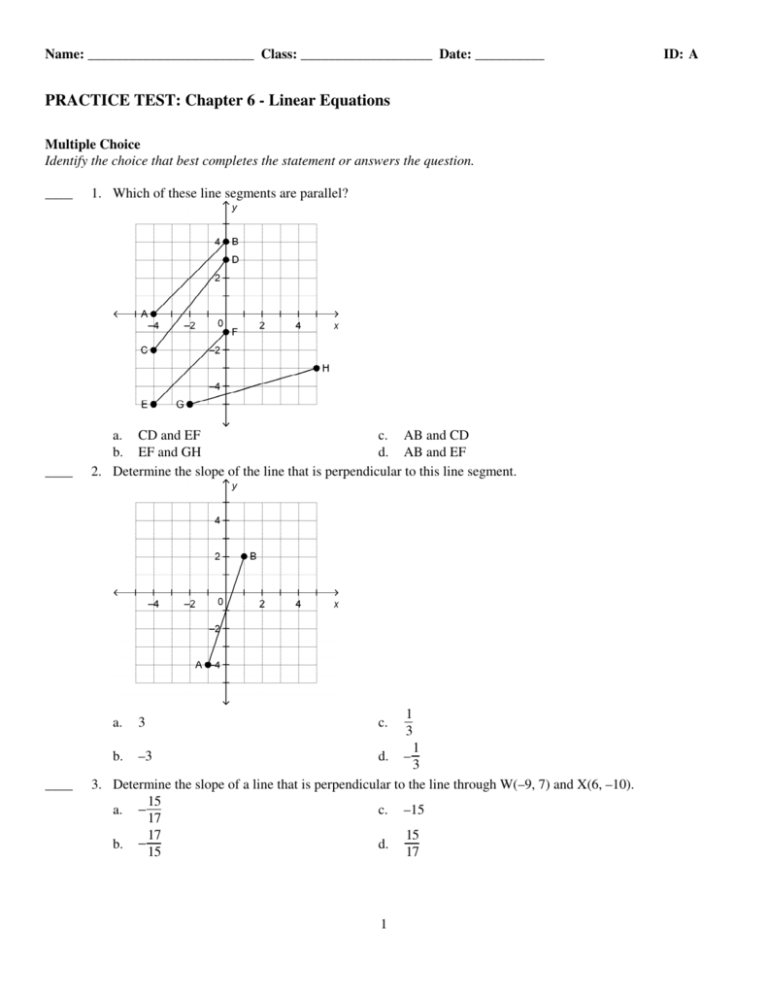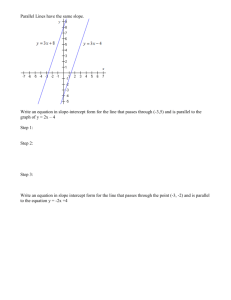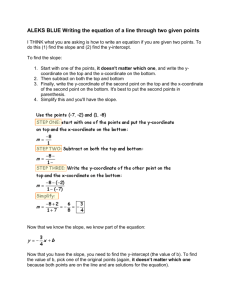Linear Equations Practice Test - High School Math
advertisement

Name: ________________________ Class: ___________________ Date: __________ PRACTICE TEST: Chapter 6 - Linear Equations Multiple Choice Identify the choice that best completes the statement or answers the question. ____ 1. Which of these line segments are parallel? ____ a. CD and EF c. AB and CD b. EF and GH d. AB and EF 2. Determine the slope of the line that is perpendicular to this line segment. 1 3 1 b. –3 d. – 3 3. Determine the slope of a line that is perpendicular to the line through W(–9, 7) and X(6, –10). 15 a. − c. –15 17 17 15 b. − d. 15 17 a. ____ 3 c. 1 ID: A Name: ________________________ ____ ID: A 4. Determine the slope of the line that is parallel to this line segment. ____ 5. ____ 6. ____ 7. ____ 8. ____ 9. 3 3 c. 7 7 7 7 b. d. – 3 3 Determine the slope of a line that is parallel to the line through L(–6, 3) and K(12, –9). 2 2 a. c. − 3 3 3 3 b. d. − 2 2 A line has x-intercept 4 and y-intercept –5. Determine the slope of a line perpendicular to this line. 4 5 a. − c. 5 4 5 4 b. − d. 5 4 A line passes through J(–10, 10) and K(7, –9). Determine the coordinates of L so that line JL is perpendicular to line JK. a. L(27, 9) c. L(17, –19) b. L(–19, 17) d. L(9, 27) A line passes through D(–5, 3) and N(12, –4). Determine the coordinates of two points on a line parallel to DN. a. (6, –10) and (24, –8) c. (–10, 6) and (24, –8) b. (–10, 24) and (6, –8) d. (–10, 6) and (–8, 24) 1 Write an equation for the graph of a linear function that has slope − and y-intercept –3. 3 a. – a. y = −3x − 1 3 c. b. 1 y = − x−3 3 d. 2 1 x+3 3 1 y = 3x − 3 y= Name: ________________________ ID: A ____ 10. Write an equation for the graph of a linear function that has slope 1 and y-intercept 8. a. b. y = x+8 y = −8x + −1 c. d. y = 8x + 1 y = −x − 8 2 ____ 11. Which graph represents the equation y = − x + 1? 5 a. c. b. d. ____ 12. Which equations represent parallel lines? a. y = 8x + 8, y = −5x + 8 c. b. y = 14x − 5, y = −5x + 8 d. ____ 13. Which equations represent perpendicular lines? a. y = 6x − 7, y = 6x + 7 b. y = −7x + 11, y = 1 x+6 7 y = 8x − 5, y = 14x + 14 y = −5x + 14, y = −5x + 8 c. y = 11x − 7, y = 11x + d. y= 3 1 x + 6, y = 6x + 6 6 1 7 Name: ________________________ ID: A ____ 14. Write an equation to describe this graph. 1 y = − x −1 c. 5 1 b. y = − x + 1 d. 5 ____ 15. Determine the slope and y-intercept of this graph. a. a. b. 3 ; y-intercept: 1.5 4 3 slope: 1.5; y-intercept: 4 slope: c. d. 4 1 x −1 5 1 y= x+1 5 y= 3 slope: ; y-intercept: –1.5 4 3 slope: − ; y-intercept: 1.5 4 Name: ________________________ ID: A ____ 16. Describe the graph of the linear function with this equation: y + 3 = 1 . 3 1 b. The graph is a line through (2, −3) with slope . 3 1 c. The graph is a line through (2, −3) with slope − . 3 1 d. The graph is a line through (–2, 3) with slope − . 3 Write an equation for the graph of a linear function that has slope 8 and passes through R(4, −3). a. y + 3 = −8(x − 4) b. y + 3 = 8(x − 4) 1 c. y + 3 = (x − 4) 8 d. y − 3 = 8(x + 4) 2 Write an equation for the graph of a linear function that has slope and passes through S(–4, 5). 7 2 a. y + 5 = (x − 4) 7 2 b. y − 5 = − (x + 4) 7 7 c. y − 5 = − (x + 4) 2 2 d. y − 5 = (x + 4) 7 1 Write this equation in slope-intercept form: y − 3 = − (x + 2) 5 1 13 13 a. y = − x + c. y = −x + 5 5 5 3 13 1 13 b. y = − x + d. y = x + 5 5 5 5 2 Write this equation in slope-intercept form: y − 3 = − (x + 10) 7 2 1 a. y = x + c. y = −7x + 1 7 7 2 1 1 2 b. y = − x + d. y = − x + 7 7 7 7 Determine the y-intercept of the graph of this equation: y − 3 = 4(x + 5) a. 3 c. 23 b. −23 d. −20 a. ____ 17. ____ 18. ____ 19. ____ 20. ____ 21. 1 (x − 2) 3 The graph is a line through (–2, 3) with slope 5 Name: ________________________ ____ 22. Which graph represents the equation y + 1 = a. b. ID: A 3 (x + 3)? 4 c. d. ____ 23. Write an equation in slope-point form for the line that passes through A(–2, 4) and B(–9, 6). 2 2 c. y − 4 = − (x + 2) a. y − 6 = − (x + 2) 7 7 2 2 b. y + 4 = − (x − 2) d. y + 6 = (x − 2) 7 7 ____ 24. Write an equation in slope-point form for the line that passes through A(1, 4) and B(6, 8). 4 4 a. y + 8 = (x − 1) c. y − 4 = (x − 1) 5 5 4 4 b. y + 4 = − (x − 1) d. y − 8 = − (x + 1) 5 5 6 Name: ________________________ ID: A ____ 25. Write an equation in slope-point form for this line. 1 1 (x − 2) c. y − 2 = − (x − 2) 2 2 1 1 b. y + 2 = − (x + 2) d. y + 2 = (x + 2) 2 2 ____ 26. Write an equation for the line that passes through T(–3, 3) and is parallel to the line y = 7x − 10. 1 1 c. y − 3 = − (x + 3) a. y + 3 = − (x − 3) 7 7 b. y + 3 = 7(x − 3) d. y − 3 = 7(x + 3) ____ 27. Write an equation for the line that passes through U(3, –7) and is perpendicular to the line 1 y = x − 9. 7 1 a. y + 7 = − (x + 3) c. y + 7 = −7(x − 3) 7 b. y − 7 = 7(x + 3) d. y + 7 = 7(x − 3) ____ 28. Write this equation in general form: y = 3x + 5 a. −3x + y − 5 = 0 c. 3x − y + 5 = 0 b. 3x + y + 5 = 0 d. 3x − y − 5 = 0 a. y−2 = 3 ____ 29. Write this equation in general form: y = − x + 8 2 a. 3x + 2y − 16 = 0 c. b. 3x − 2y + 8 = 0 d. 3x + 2y − 8 = 0 −3x − 2y − 16 = 0 ____ 30. Determine the slope of the line with this equation: 7x + 3y + 5 = 0 7 7 a. – c. 3 3 3 3 b. d. – 7 7 7 Name: ________________________ ID: A ____ 31. Write this equation in slope-intercept form: 10x + 3y − 4 = 0 10 4 10 4 a. y = x + c. y = x – 3 3 3 3 10 4 10 b. y = – x + d. y = – x – 4 3 3 3 ____ 32. Which graph represents the equation 4x − 6y − 12 = 0? a. c. b. d. ____ 33. A line has x-intercept –9 and y-intercept 3. Determine the equation of the line in general form. a. 3x + 9y − 27 = 0 c. 3x − 9y + 27 = 0 b. 3x − 9y − 27 = 0 d. 3x + 9y + 27 = 0 ____ 34. For the function f x = −3x + 8, determine f(−2). a. 7 b. 2 c. 14 ____ 35. For the function f x = −3x + 8, determine x when f x = −25. a. 83 b. –67 c. 8 11 d. 3 d. –11 Name: ________________________ ID: A ____ 36. For the function g x = 2x − 9, determine g(3.4). b. 2.2 c. –3.6 a. –2.2 ____ 37. For the function g x = 2x − 9, determine x when g x = −15. a. –3 b. 12 c. –39 d. 6.2 d. –12 Short Answer 38. Are these two line segments parallel, perpendicular, or neither? 39. Graph the line with y-intercept 3 and slope –2. 40. Write an equation for the line that passes through E(–3, –7) and F(2, 10). Write the equation in slope-point form and in slope-intercept form. 41. Write this equation in general form: y = 9 x−7 4 42. Determine the slope of the line of this equation: 9x + 5y − 13 = 0 9 Name: ________________________ ID: A 43. What is f(-3)? 44. What is f(4)? 10 Name: ________________________ ID: A Problem 45. Reggie says FGHJ is a parallelogram. Ann says FGHJ is a rectangle. Who is correct? Justify your answer. 46. In Canada, the number of girls playing organized ice hockey from January 1990 to January 2010 increased by approximately 4162 girls per year. In January 2000, there were approximately 45 400 girls playing organized ice hockey. a) Write an equation in slope-point form to represent the number of girls, n, playing organized ice hockey as a function of the number of years, t, after 1990. b) Use the equation in part a to estimate the number of girls playing organized ice hockey in January 2009. . . . . . . 47. Write an equation for the line that passes through B(–1, 3) and is: 7 a) parallel to the line y = − x − 3 3 7 b) perpendicular to the line y = − x − 3 3 . . . . . 48. Determine the slope of a line that is perpendicular to the line with this equation: −8x + 3y + 7 = 0 11 ID: A PRACTICE TEST: Chapter 6 - Linear Equations Answer Section MULTIPLE CHOICE 1. 2. 3. 4. 5. 6. 7. 8. 9. 10. 11. 12. 13. 14. 15. 16. 17. 18. 19. 20. 21. 22. 23. 24. 25. 26. 27. 28. 29. 30. 31. 32. 33. 34. 35. 36. 37. D D D C C A D C B A B D B A A B B D A B C C C C A D C C A A B A C C C A A 1 ID: A SHORT ANSWER 38. Neither 39. 17 (x + 3) 5 17 16 y= x+ 5 5 40. y + 7 = or 17 (x − 2) 5 17 16 y= x+ 5 5 9x − 4y − 28 = 0 9 − 5 Horizontal intercept: 3 Vertical intercept: 2 Rate of change: −1; vertical intercept: 2 y − 10 = 41. 42. 43. 44. 2 ID: A PROBLEM 45. A parallelogram has opposite sides equal. To check whether FGHJ is a parallelogram, determine whether opposite sides are parallel. Write the coordinates of the vertices: F(−3,−2), G(−1,2), H(4,1), J(2,−3), y2 − y1 Slope of GH = x2 − x1 1−2 4 − (−1) −1 Slope of GH = 5 1 The slope of GH is − . 5 Slope of GH = Slope of FJ = y2 − y1 x2 − x1 −3 − (−2) 2 − (−3) −1 Slope of FJ = 5 1 The slope of FJ is − . 5 Slope of FJ = Slope of HJ = y2 − y1 x2 − x1 (−3) − 1 2−4 −4 Slope of HJ = −2 The slope of HJ is 2. Slope of HJ = Slope of GF = y2 − y1 x2 − x1 (−2) − 2 −3 − (−1) −4 Slope of GF = −2 The slope of GF is 2. Slope of GF = The slopes of opposite sides are equal, so FGHJ is a parallelogram. A rectangle has angles that are right angles. To check whether FGHJ is a rectangle, determine whether two intersecting sides are perpendicular. Determine whether GF is perpendicular to GH. 3 ID: A The slope of GF is 2. 1 The slope of GH is − . 5 Since the slopes of GF and GH are not negative reciprocals, GF and GH are not perpendicular. This means that ∠FGH is not a right angle and that FGHJ is not a rectangle. So, Reggie is correct. 46. a) The increase in girls playing organized ice hockey is 4162 girls per year. This is the slope of a graph of this function. The year 2000 is 2000 − 1990 = 10 years after 1990. So, an ordered pair that satisfies this function is: (10, 45 400) Use the slope-point form of the equation of a linear function: y − y 1 = m(x − x 1 ) Replace y with n, and replace x with t. n − n 1 = m(t − t 1 ) Substitute m = 4162, n 1 = 45 400, and t 1 = 10 into the equation. n − 45 400 = 4162(t − 10) b) The year 2009 is 19 years after 1990. Substitute t = 19 in the equation: n − 45 400 = 4162(t − 10) n − 45 400 = 4162(19 − 10) n − 45 400 = 4162(9) n − 45 400 = 37 458 n = 82 858 There were approximately 82 858 girls playing organized ice hockey in January 2009. 4 ID: A 47. 7 Sketch the line with equation: y = − x − 3, 3 and mark a point at B(–1, 3). 7 Compare the equation: y = − x − 3 with the 3 equation: y = mx + b 7 The slope of the line is − . 3 7 7 a) Any line parallel to y = − x − 3 has slope − . 3 3 The required line passes through B(–1, 3). Use: y − y 1 = m(x − x 1 ) 7 Substitute y 1 = 3, x 1 = −1, and m = − . 3 7 y − 3 = − [x − (−1)] 3 7 y − 3 = − (x + 1) 3 7 The line that is parallel to the line y = − x − 3 and passes through B(–1, 3) has equation: 3 7 y − 3 = − (x + 1) 3 7 7 b) Any line perpendicular to y = − x − 3 has a slope that is the negative reciprocal of − ; that is, its slope 3 3 3 is . 7 The required line passes through B(–1, 3). Use: y − y 1 = m(x − x 1 ) Substitute y 1 = 3, x 1 = −1, and m = 3 . 7 5 ID: A y−3 = 3 [x − (−1)] 7 y−3 = 3 (x + 1) 7 7 The line that is perpendicular to the line y = − x − 3 and passes through B(–1, 3) has equation: 3 3 y − 3 = (x + 1) 7 48. Rewrite the equation in slope-intercept form. −8x + 3y + 7 = 0 3y + 7 = 8x 3y = 8x − 7 y= 8 7 x− 3 3 8 . Any line perpendicular to −8x + 3y + 7 = 0 has a slope that is the 3 3 8 negative reciprocal of ; that is, its slope is − . 3 8 From the equation, the slope of the line is 6




